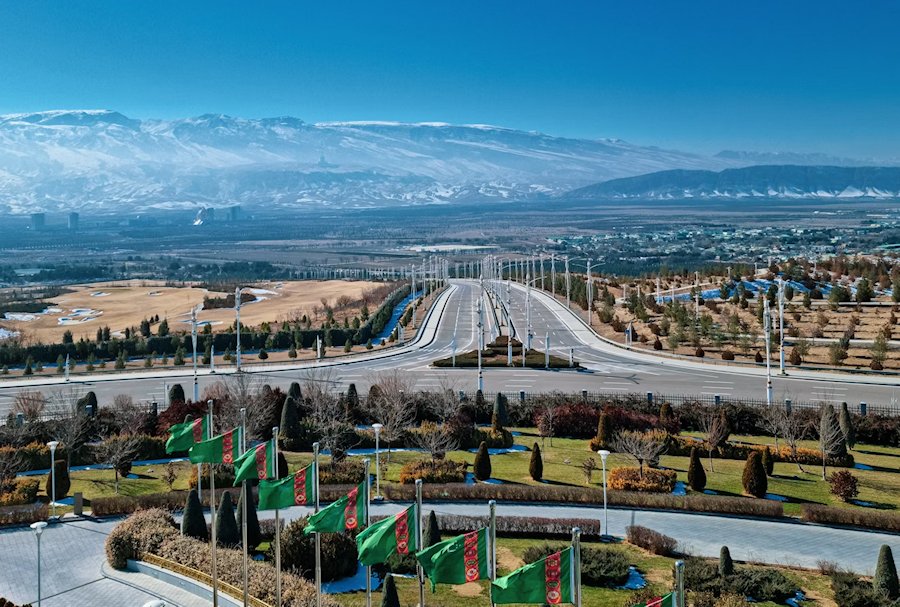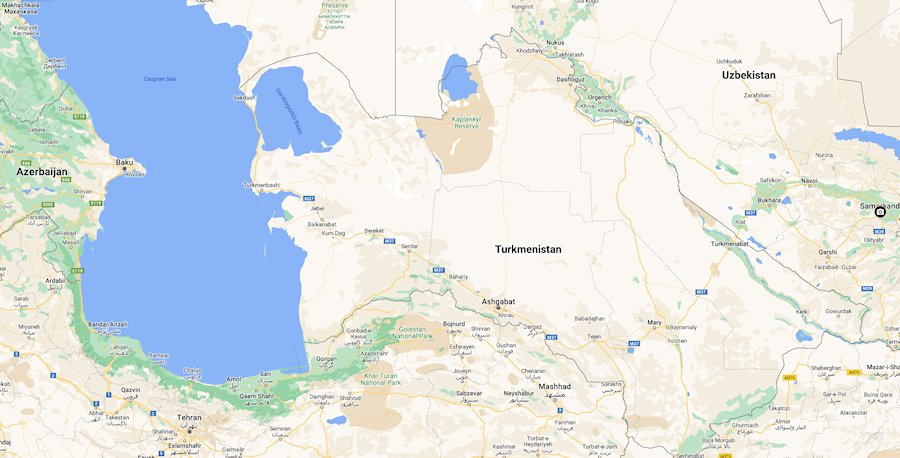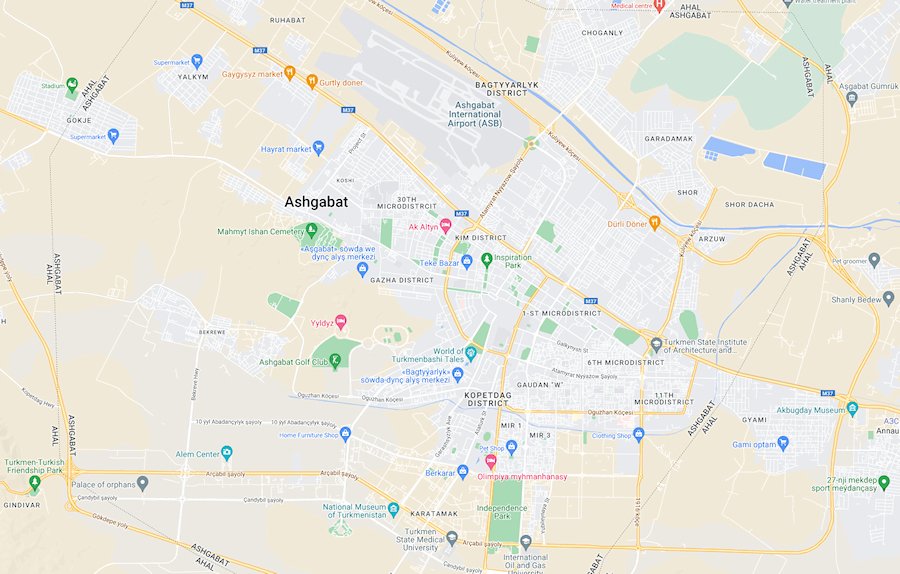Travel Notes: Asia - Turkmenistan Travel Notes.
Short URL: https://tnot.es/TM
Turkmenistan Travel and Tourism on Travel Notes
Explore the architectural marvels of Turkmenistan and discover UNESCO World Heritage Sites like Kunya Urgench and Merv, remnants of a glorious past.
About Turkmenistan
Turkmenistan is a country with a rich cultural heritage, significant natural resources, and a complex political landscape.
Turkmenistan was a former republic of the Union of Soviet Socialist Republics.
Countries neighbouring Turkmenistan are: Kazakhstan, Uzbekistan, Afghanistan and Iran.
 Add a Business - Add a Location -
Add a Lodging - Add Travel Content
- Add URL
- Travel Services.
Add a Business - Add a Location -
Add a Lodging - Add Travel Content
- Add URL
- Travel Services.
Mapping Turkmenistan
Map of Turkmenistan
Turkmenistan forms a region known as Central Asia; together with Kazakhstan, Kyrgyzstan, Tajikistan and Uzbekistan.
The capital of Turkmenistan is Ashgabat.
Turkmenistan Overview
Turkmenistan is bordered by Kazakhstann to the north-west, Uzbekistan to the north and east, Afghanistan to the south-east, Iran to the south, and the Caspian Sea to the west.
Culture
Turkmenistan has a rich cultural heritage influenced by its history as part of the Silk Road; with Turkmen carpets renowned worldwide for their intricate designs and craftsmanship.
The majority of the population is Turkmen, and the culture is deeply rooted in nomadic traditions.
The country celebrates various cultural festivals and has a vibrant music and dance scene.
Economy
Turkmenistan has significant reserves of natural gas, which forms the backbone of its economy. The country also has some oil resources.
However, the economy heavily relies on gas exports, which exposes it to fluctuations in global energy markets.
Efforts have been made to diversify the economy, particularly in sectors like agriculture and textiles.
Government
Turkmenistan is a presidential republic, where the President is both the head of state and head of government.
The political system has been dominated by the Democratic Party of Turkmenistan.
History
Turkmenistan has a long and complex history, with influences from various civilisations, including Persian, Mongol, and Russian.
It was part of the Soviet Union until its dissolution in 1991 when it gained independence.
Since then, Turkmenistan has experienced a period of authoritarian rule under its first president, Saparmurat Niyazov, followed by Gurbanguly Berdimuhamedow, who has also held a strong grip on power.
Human Rights
Turkmenistan has been criticised by human rights organisations for its lack of political freedoms, restrictions on freedom of speech and the press, and its poor record on human rights.
Language
The official language of Turkmenistan is Turkmen, which is a Turkic language.
Russian is also widely spoken, especially in urban areas and among older generations.
Religion
Islam is the predominant religion in Turkmenistan, with the majority of the population adhering to Sunni Islam.
However, the government exerts strict control over religious activities, and there is limited freedom of religion.
Tourism
Turkmenistan has started to promote tourism in recent years, capitalising on its unique historical sites such as the ancient city of Merv and the Darvaza Gas Crater.
However, the country's strict visa regulations and limited infrastructure remain significant barriers to tourism development.
Visiting Turkmenistan
Visiting Turkmenistan offers travellers a glimpse into a unique Central Asian culture and history.
Check visa requirements and travel advisories before planning your trip to Turkmenistan, as regulations may vary depending on your nationality and current geopolitical situations.
Additionally, consider hiring a local guide or joining a tour to make the most of your experience and ensure smooth travel logistics.
Ancient Cities
Explore the ancient Silk Road cities of Merv and Konye-Urgench, both UNESCO World Heritage Sites.
These cities boast impressive archaeological ruins, including ancient mosques, mausoleums, and fortresses, providing insights into Turkmenistan's rich history as a crossroads of civilisations.
Ashgabat
Start your journey in the capital city, Ashgabat, known for its grandiose architecture, marble-clad buildings, and wide, meticulously maintained avenues.
Don't miss the Turkmenbashi Ruhy Mosque, Independence Monument, and the Arch of Neutrality.
Avaza
Relax on the shores of the Caspian Sea in Avaza, Turkmenistan's resort town known for its sandy beaches, luxury hotels, and recreational activities like water sports and yacht cruises.
Darvaza Gas Crater
One of Turkmenistan's most famous attractions is the Darvaza Gas Crater, often referred to as the 'Door to Hell'.
This flaming crater in the Karakum Desert (near Derweze) is a surreal sight, especially at night.
Turkmen Culture
Immerse yourself in Turkmen culture by visiting local bazaars, trying traditional cuisine such as kebabs, pilaf, and flatbreads, and experiencing Turkmen hospitality firsthand.
You may also encounter Turkmenistan's national symbols, including the Akhal-Teke horse and the Alabay dog.
Turkmenistan's National Museum
Gain deeper insights into Turkmenistan's history, culture, and traditions at the National Museum of Turkmenistan, in Ashgabat.
The museum houses a diverse collection of artifacts, including archaeological finds, traditional textiles, and contemporary art.
Visit Ancient Nisa
Explore the ancient Parthian city of Nisa, another UNESCO World Heritage Site, which dates back to the 3rd century BC.
Marvel at the remains of the royal palace, fortifications, and temple complex, providing insights into Turkmenistan's ancient history.
Yangykala Canyon
Marvel at the stunning landscapes of Yangykala Canyon, characterised by its striking rock formations, vibrant hues, and dramatic cliffs.
It's a great spot for hiking, photography, and enjoying the natural beauty of Turkmenistan.
The Turkmens
The Turkmens, or Turkomans, are a Turkic- speaking people with a Sunni Muslim religious heritage.
Turkmens have lived in the area for centuries, becoming a distinct ethnic group by the 15th century, but have done little with it. Okay, they make nice carpets.
The last Central Asian territory to come under Russian control, the Turkmen stronghold of Geok-Tepe, fell in 1881.
Ashgabat
Map of Ashgabat
The capital of Turkmenistan is in the south-west of the country.
Ashgabat, formerly Ashkhabad, is located in an oasis near the Garagum desert and the border with Iran.
The city grew around a Russian fortress, built in 1881, at the junction of caravan routes, and became a station on the Trans-Caspian Railway in 1885.
Where to Stay in Turmenistan
Garagum Desert
Occupying most of Turkmenistan; the name means black sand in Turkic.
The desert extends from the Ust-Urt plateau in the north to the Kopet-Dag Mountains in the south, and from the Amu Darya River in the east towards the Caspian Sea region in the west.
Turkmenistan and Niyazov
The political situation didn't alter much in Turkmenistan after independence in 1991 - the Communist party of the Turkmen Soviet Socialist Republic changed its name to the Democratic party of Turkmenistan, but the same people were in it.
Whatever token opposition existed seemed to support Niyazov in referendums; keeping everything but the name the same, and everything else getting named after him.
Turkmenistan Travel Guides
Turkmenistan Travel - Turkmenistan Maps.
Weather in Asia:
Local weather forecasts for destinations around Asia.
More From Travel Notes
Travel Notes Online Guide to Travel
Africa - Asia - Caribbean - Europe - Middle East - North America - Oceania - South America.
The Travel Notes Online Guide to Travel helps visitors plan their trip with country and city travel guides, local tourist information, reviewed web sites, and inspiring travel content.
Travel and Tourism Guides on Travel Notes
If Travel Notes has helped you, please take a moment to like us on Facebook and share with your friends on social media.
Travel Resources
.
Travel & Tourism With Industry Professionals.













